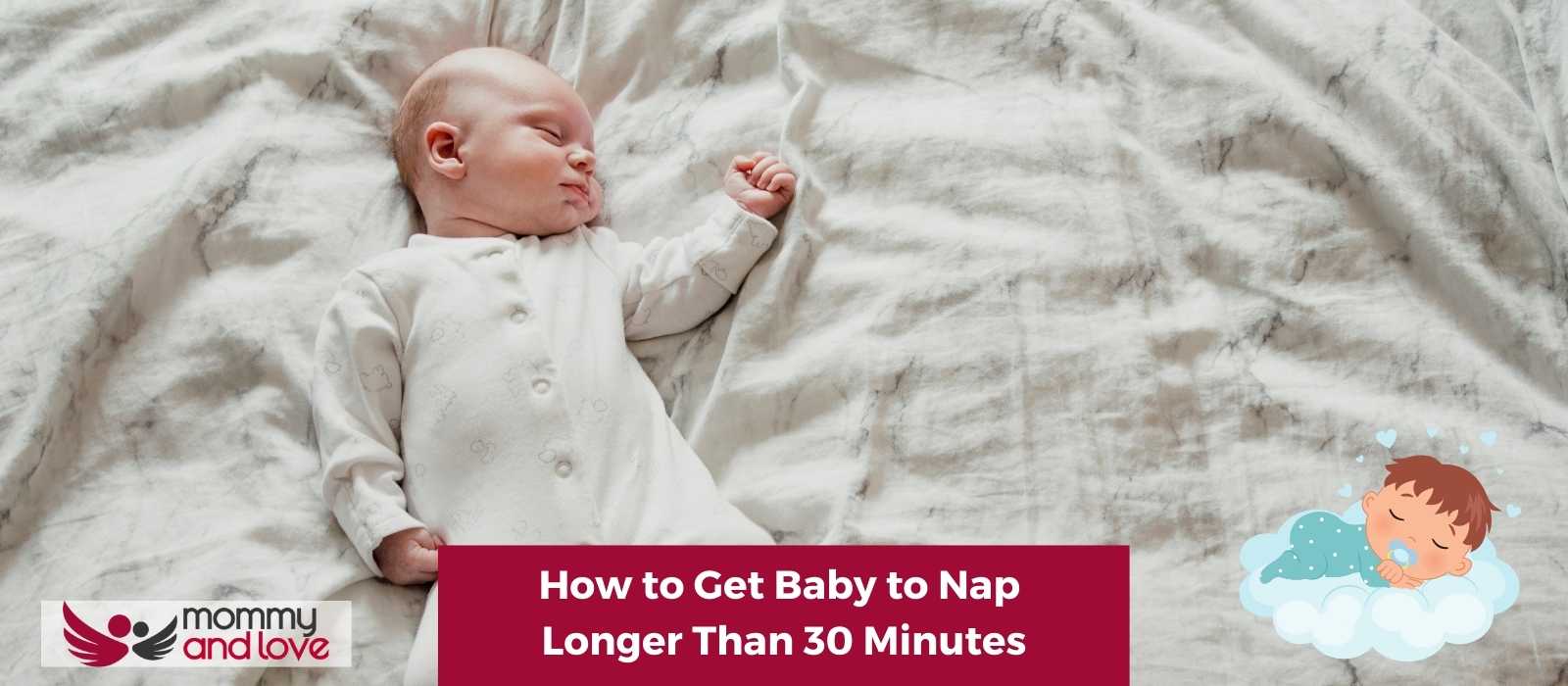Newborn sleep can be quite sporadic, with short naps often lasting only 30 minutes or going up to 2 hours. A 30-minute nap is still a good nap for a baby under 12 weeks old. However, there are many things you can do to get your baby napping for more than 30 minutes.
Here are a few sleep tips on how to lengthen your baby’s short naps.
Create a Nap Time Routine That Works for Both the Parent and Your Baby.
A simple nap and sleep routine for babies could involve a bath, reading a story, and then putting the baby to bed. A good nap routine can make all the difference in your baby’s mood and energy level.
When it comes to naps, every baby is different. Some babies take multiple short naps during the day while others fewer, longer naps. It’s important to experiment to find what works best for your child.
Here are a few tips to create a routine to lengthen short naps and get your baby into a longer nap:
- Keep it consistent. Try to stick to the same nap schedule every day, so your baby knows when it’s time to sleep.
- Make your baby sleep in a safe, peaceful environment by keeping the noise level low and the lights dim.
- Give your baby a warm bath before nap time. This can help relax your baby and make them sleepy which can help them into a long nap and help prevent an overtired baby.
- Put on some soft music or white noise in the background. This can help soothe your baby and block out any outside noises. It also helps them stay asleep if they suddenly wake up from their sleep.
- Read a bedtime story. This is a great way to wind down your baby before nap time.
- Sing a lullaby. This can help your baby relax and get ready for sleep.
Use Age-Appropriate Wake Windows.
It’s important to use age-appropriate wake windows when trying to get your baby to nap for more than 30 minutes. A wake window is the amount of time a baby should be awake before they need to go back to sleep
For example, a newborn’s awake window is typically around 60 minutes, while a 3-month-old’s wake window is around 2 hours
If you’re not following the right wake windows for your baby, it’s likely the reason why she is only taking a short nap. Keep your baby awake for too long between sleep periods and she’ll be overtired, leading to a short nap. Not keeping your baby awake long enough won’t give her enough sleep pressure to take a good, long nap.
If your baby takes a short nap of no more than 30 minutes, it’s likely because their wake window is too short. Try lengthening their wake time by 15-30 minutes and see if that helps them sleep for longer periods of time.
Set Up a Safe and Optimum Sleep Environment
Setting up a safe baby’s sleep environment is key to getting your baby to nap for longer than 30 minutes. By creating a calm and relaxing atmosphere, you can help your baby relax and fall asleep more easily.
Here’s how to set up your baby’s room for optimum naps and sleep.
- A quiet, dark room is the perfect room for a baby to sleep in.
- Keep the temperature cool, around 68-72 degrees F (20 to 22 degrees Celsius).
- Place the crib in a calm and soothing environment.
- Hang blackout curtains to block out all light.
- Use a noise machine to create white noise or natural sounds.
- Put away all distractions, such as toys and electronics.
- Make sure the crib is comfortable with a firm mattress and clean fitted sheets.
- Use a sleep sack or swaddle to help your baby feel cozy and secure.
- Take all stuffed animals out of the crib.
- Keep the door closed to prevent outside noise from disturbing your baby’s sleep.
Teach the Baby Independent Sleep Habits

It is important to teach babies how to fall asleep independently and take long, restful naps.
This approach is called sleep training and it will help them learn how to be independent and not rely on others to get to sleep.
Falling asleep without the need for assistance is a skill that every child needs to learn.
Here’s how you can help your baby learn the skill of falling asleep without any assistance or help from you and start taking restorative naps.
- Start by establishing a bedtime routine and sticking to it. Having a routine will make your baby fall asleep on her own. A routine will make them feel more comfortable and help them know what to expect on the first nap of the day.
- When you put the baby to bed, you want them to be drowsy but still slightly awake. This will help them fall asleep easily. Put them in their bed, and then sit with them until they fall asleep. You can stay for a few minutes or until they are asleep.
- Break negative sleep associations. Sleep associations are the behaviors or objects that babies associate with sleep. Some common sleep associations include being rocked to sleep, being in a crib, and having a favorite toy.It is important to break any bad baby sleep habits early on. This will help the baby learn how to fall asleep on their own without needing help from others. Start by breaking the sleep association that is the most difficult to break. For example, if your baby is used to being rocked to sleep, start by putting them down for naps in their crib instead.
- Pay close attention to sleep cues. Is my baby tired and ready for bed? Young babies usually tug their earlobes, rub their eyes and yawn if they want to go to bed.
- Is my baby hungry? Most babies wake up from their day sleep if they’re hungry. So make sure you adjust the feeding time to prevent frequent wakings.
- The “Eat, Play, Sleep” method is a way to organize your baby’s naps and feedings throughout the day. With this routine, your baby will eat, play during her awake time, and then sleep. When she wakes up, she’ll eat again and the cycle will repeat.
- Don’t pick up the baby every time they cry. If your baby wakes up and is truly upset, you can console her, but try to let them cry it out if possible. Crying is the baby’s way of communicating and you should respond to her needs. However, you can try to let her cry it out if possible so that she can learn how to fall back to sleep and start a new sleep cycle through self-soothing.
- Be consistent with your approach and eventually the baby will learn to fall asleep and go back to sleep if they wake up during their night and day sleep.
Swaddle Your Baby
Swaddling is the wrapping of a baby in a cloth. It helps keep the baby warm, calm, feel secure, and comfortable.
Swaddling helps a baby to sleep better because it recreates the familiar feel of the mother’s uterus. This makes the baby feel safe and calm. Swaddling also prevents the baby from startle reflex, which can wake the baby up. So if your baby is only taking short naps, try swaddling.
Practice Crib Hour

Crib hour is a time-tested way to get your baby to sleep through the night as well as lengthen short naps.
For one hour, from the minute he falls asleep, your baby is in the crib. For example, if you put your baby down for a daytime sleep or nap at 10:00 AM, she fell asleep at 10:15 AM then crib hour would end at 11:15 AM. If your baby wakes up before the crib hour is over, it will help her learn how to self-soothe herself to fall back to sleep.
Adjusting the Feeding Schedule

If your baby is taking short naps, adjusting the baby’s feeding schedule might help make your baby’s naps longer.
This can be done by giving them a larger morning feeding and then waiting a bit longer to give the next feeding.
It may also be helpful to push back the bedtime feeding by an hour or so. By doing this, the baby will be more likely to sleep through the night and have longer naps during the day.
Putting the Baby to Fall Asleep Earlier
Many parents have found that putting the baby to bedtime earlier than usual can lengthen the baby’s daytime naps. By putting the baby to bed earlier, the baby will have more sleep at night and wake up earlier in the morning and be able to take longer naps during the day.
Conclusion on How to Get Baby to Nap Longer Than 30 Minutes
It can be tough to get your little one on a nap schedule, but with a little bit of persistence and some of the tips we’ve shared, you should be able to help them sleep for longer periods of time. Nap time is crucial for newborns so that they can recharge and continue growing and developing. Keep at it and soon enough your baby will be taking long naps like a pro!
FAQs on Baby Taking Short Naps
Are 30-Minute Naps Enough for a Baby?
Short naps of 30 minutes are enough for the baby because they will help them recharge their batteries and get some energy back. Babies are constantly learning and growing, so they need plenty of sleep to continue doing so. 30-minute short naps will be just enough to give them the energy they need to keep going throughout the day.
Many babies only nap for 30 minutes, but this is normal and usually won’t last long. If you are following independent sleep habits and other recommended practices, there may be some things you can do to encourage a long nap.
Why Does My Baby Wake Up Every 30 Minutes?
A baby taking short naps and waking up every 30 minutes is normal. It is their natural sleep cycle. Younger babies usually sleep 14-17 hours a day, but they wake up every few hours to eat. By the time they are four or six months old, their sleep patterns usually change and they will start to sleep for longer periods of time, but they might still wake up every 30 minutes or so.
How Long Is One Sleep Cycle?
Babies have different sleep cycles than adults. One sleep cycle of an adult lasts about 90 minutes, but baby sleep cycles, especially those in the newborn stage, are shorter, lasting only 40-50 minutes. This means that babies wake up more often than adults do. And that’s why they take short naps during the day.
When Can Babies Link Sleep Cycles?
As your baby enters the 4-6 month range, you’ll likely notice that they start taking longer and more consistent naps. When babies start to link their sleep cycles, so you may start to see them taking one 1-hour nap and then another 1-hour nap a few hours later.
Do Nap Routines Help Improve Night Sleep for Babies?
Just like adults, babies need enough night sleep to be healthy and happy. One way to help ensure that your baby gets the best sleep possible is to establish a regular nap routine.
Healthy napping patterns and routines help improve a baby’s sleep. Many babies find it helpful to take a morning nap and another afternoon nap shortly after lunchtime. If your baby takes naps inconsistently or not at all, it may be difficult for to make the baby sleep through the night.
Why Do Some Babies Take Short Naps?
Babies sometimes take short naps because they are overtired. Overtired babies will wake up frequently. While some babies take shorter naps because they are in a growth spurt and spend more time being awake.
In some cases, the baby’s body is not tired enough that there’s no sleep pressure to stay asleep after waking up which makes it difficult for them to transition to the next sleep cycle.
What Happens During Nap Transitions?
A nap transition is when your child reduces the number of baby naps they take during the day. For example, if a child goes from taking 3 to 2 baby naps, that’s considered a nap transition. The baby’s naps will be fewer as she grows older.

This article was written by: Gian MIller – Full-Time Writer, Baby Whisperer & Dad of 3.
Gian spends a lot of his time writing. A self-proclaimed baby whisperer, Gian has been through it all with his own children and is passionate about sharing his hard-won wisdom with other parents. When he’s not writing or changing diapers, you can find him playing the guitar or watching baseball (or preferably both at the same time).




